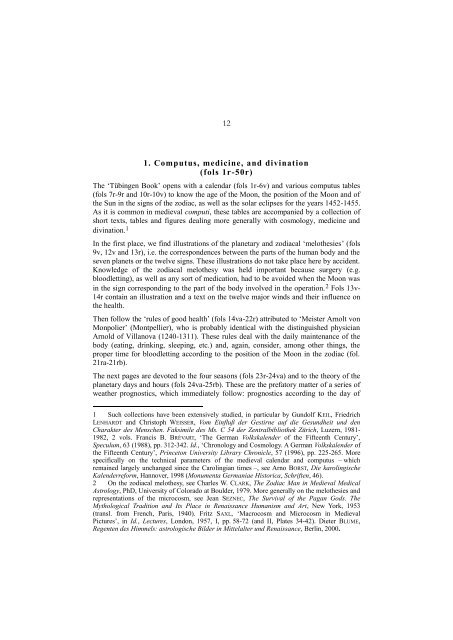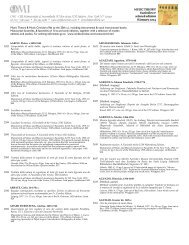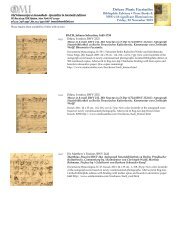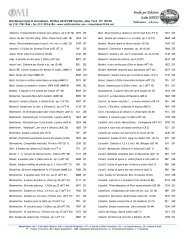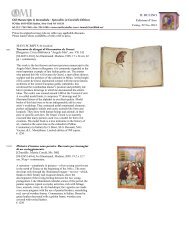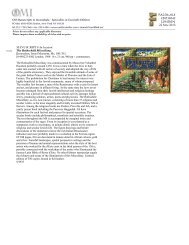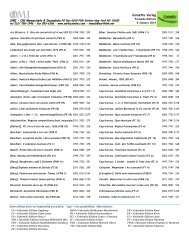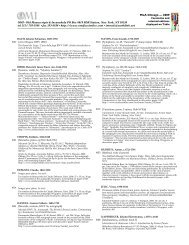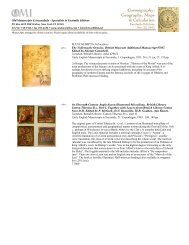CIMA 63 Titel Inhalt
CIMA 63 Titel Inhalt
CIMA 63 Titel Inhalt
Sie wollen auch ein ePaper? Erhöhen Sie die Reichweite Ihrer Titel.
YUMPU macht aus Druck-PDFs automatisch weboptimierte ePaper, die Google liebt.
12<br />
1. Computus, medicine, and divination<br />
(fols 1r-50r)<br />
The ‗Tübingen Book‘ opens with a calendar (fols 1r-6v) and various computus tables<br />
(fols 7r-9r and 10r-10v) to know the age of the Moon, the position of the Moon and of<br />
the Sun in the signs of the zodiac, as well as the solar eclipses for the years 1452-1455.<br />
As it is common in medieval computi, these tables are accompanied by a collection of<br />
short texts, tables and figures dealing more generally with cosmology, medicine and<br />
divination. 1<br />
In the first place, we find illustrations of the planetary and zodiacal ‗melothesies‘ (fols<br />
9v, 12v and 13r), i.e. the correspondences between the parts of the human body and the<br />
seven planets or the twelve signs. These illustrations do not take place here by accident.<br />
Knowledge of the zodiacal melothesy was held important because surgery (e.g.<br />
bloodletting), as well as any sort of medication, had to be avoided when the Moon was<br />
in the sign corresponding to the part of the body involved in the operation. 2 Fols 13v-<br />
14r contain an illustration and a text on the twelve major winds and their influence on<br />
the health.<br />
Then follow the ‗rules of good health‘ (fols 14va-22r) attributed to ‗Meister Arnolt von<br />
Monpolier‘ (Montpellier), who is probably identical with the distinguished physician<br />
Arnold of Villanova (1240-1311). These rules deal with the daily maintenance of the<br />
body (eating, drinking, sleeping, etc.) and, again, consider, among other things, the<br />
proper time for bloodletting according to the position of the Moon in the zodiac (fol.<br />
21ra-21rb).<br />
The next pages are devoted to the four seasons (fols 23r-24va) and to the theory of the<br />
planetary days and hours (fols 24va-25rb). These are the prefatory matter of a series of<br />
weather prognostics, which immediately follow: prognostics according to the day of<br />
1 Such collections have been extensively studied, in particular by Gundolf KEIL, Friedrich<br />
LENHARDT and Christoph WEISSER, Vom Einfluß der Gestirne auf die Gesundheit und den<br />
Charakter des Menschen. Faksimile des Ms. C 54 der Zentralbibliothek Zürich, Luzern, 1981-<br />
1982, 2 vols. Francis B. BRÉVART, ‗The German Volkskalender of the Fifteenth Century‘,<br />
Speculum, <strong>63</strong> (1988), pp. 312-342. Id., ‗Chronology and Cosmology. A German Volkskalender of<br />
the Fifteenth Century‘, Princeton University Library Chronicle, 57 (1996), pp. 225-265. More<br />
specifically on the technical parameters of the medieval calendar and computus – which<br />
remained largely unchanged since the Carolingian times –, see Arno BORST, Die karolingische<br />
Kalenderreform, Hannover, 1998 (Monumenta Germaniae Historica, Schriften, 46).<br />
2 On the zodiacal melothesy, see Charles W. CLARK, The Zodiac Man in Medieval Medical<br />
Astrology, PhD, University of Colorado at Boulder, 1979. More generally on the melothesies and<br />
representations of the microcosm, see Jean SEZNEC, The Survival of the Pagan Gods. The<br />
Mythological Tradition and Its Place in Renaissance Humanism and Art, New York, 1953<br />
(transl. from French, Paris, 1940). Fritz SAXL, ‗Macrocosm and Microcosm in Medieval<br />
Pictures‘, in Id., Lectures, London, 1957, I, pp. 58-72 (and II, Plates 34-42). Dieter BLUME,<br />
Regenten des Himmels: astrologische Bilder in Mittelalter und Renaissance, Berlin, 2000.


